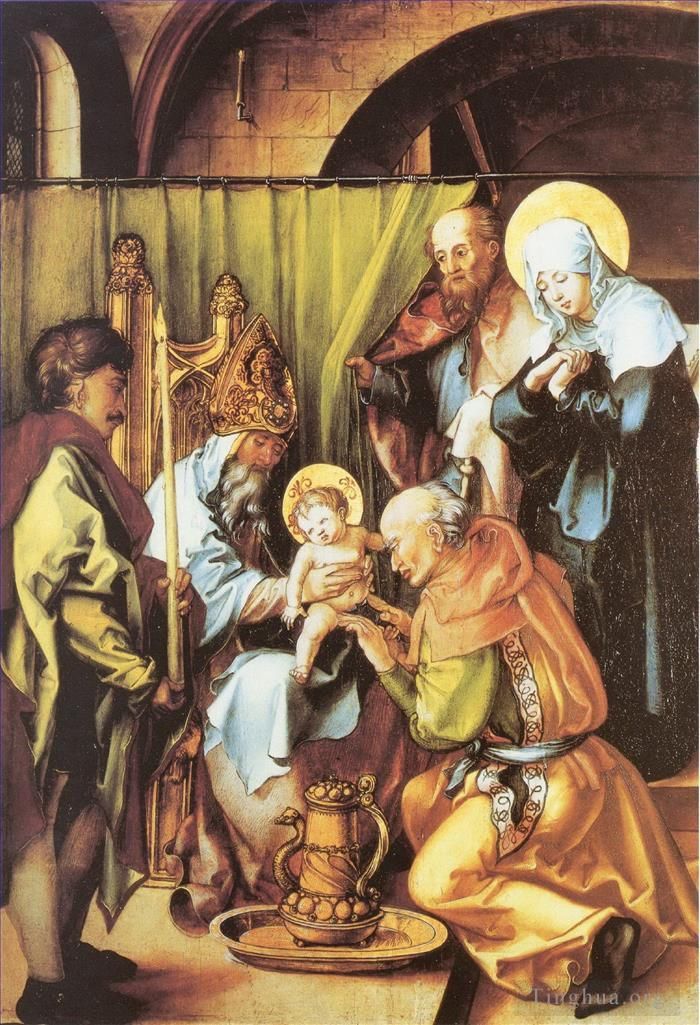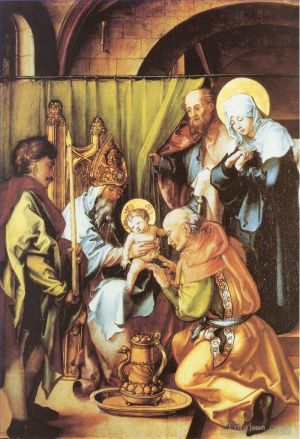Circumcision of Jesus (Seven Sorrows The Circumcision)
Albrecht Durer
- Price: Price on Request
- Art Type: Oil Painting
- Size:
- English Comments: 0
- International Comments: 0
- Creating Date:
- Introduction and Works of Albrecht Durer >>
Work Overview
- Circumcision of Jesus (Seven Sorrows: The Circumcision)
Albrecht Dürer biography
oil on panel
(63 × 45 cm)
1495-1496
Gemäldegalerie Alte Meister, Dresden
The first panel from Dürer's series on The Seven Sorrows of Mary. It might also be the second sorrow, as the exact order of circumcision and flight into Egypt can't be deduced from the gospels.
The seven sorrows are moments where either Mary witnessed Jesus suffering, or Jesus made her suffer.
The circumcision of Jesus is an event from the life of Jesus according to the Gospel of Luke, which states in verse 2:21 that Jesus was circumcised eight days after his birth (traditionally January 1). This is in keeping with the Jewish law which holds that males should be circumcised eight days after birth during a Brit milah ceremony, at which they are also given their name. The circumcision of Christ became a very common subject in Christian art from the 10th century onwards, one of numerous events in the Life of Christ to be frequently depicted by artists. It was initially seen only as a scene in larger cycles, but by the Renaissance might be treated as an individual subject for a painting, or form the main subject in an altarpiece.
The event is celebrated as the Feast of the Circumcision in the Eastern Orthodox Church on January 1 in whichever calendar is used, and is also celebrated on the same day by many Anglicans. It is celebrated by Roman Catholics as the Feast of the Holy Name of Jesus, in recent years on January 3 as an Optional Memorial, though it was for long celebrated on January 1, as some other churches still do. A number of relics claiming to be the Holy Prepuce, the foreskin of Jesus, have surfaced.
- Copyright Statement:
All the reproduction of any forms about this work unauthorized by Singing Palette including images, texts and so on will be deemed to be violating the Copyright Laws.
To cite this webpage, please link back here.
- >> English Comments
- >> Chinese Comments
- >> French Comments
- >> German Comments
- >>Report
- Emperor Charlemagne
- Virgin Suckling the Child
- Emperor Charlemagne and Emperor Sigismund
- The Apostles Philip and James
- The Cross
- Salvator Mundi
- The Dresden Altarpiece
- St Peter
- Portrait of Emperor Maximilian I
- Alliance Coat of Arms of the Durer and Holper Families
- Portrait of Jacob muffle
- Saint Jerome (St Jerome in the Wilderness)
- Paumgartner Altar right wing
- Portrait of St Sebastian with an Arrow
- Portrait of a Boy with a Long Beard
- Adam and Eve
- The Jabach Altarpiece
- Suicide of Lucretia
- The Seven Sorrows of the Virgin
- Portrait of Oswolt Krel full
- Self-Portrait (Portrait of the Artist Holding a Thistle)
- Four Apostles
- Portrait of a Young Man
- Lots escape
- Portrait of a Man 1504
- Portrait of Hieronymus Holzschuher
- St Jerome
- Twelve year old Jesus in the Temple
- Circumcision of Jesus (Seven Sorrows The Circumcision)
- John
- Christ as the Man of Sorrows
- Holy Family
- The Dresden Altarpiece central panel
- Christ among the Doctors
- Sylvan Men with Heraldic Shields Albrecht Durer
- Job and His Wife
- Maria with child
- The Four Apostles left part St John and St Peter
- The Seven Sorrows of the Virgin The Flight into Egypt
- Portrait of Elector Frederick the Wise of Saxony
- Paumgartner Altar left wing
- Portrait of Elsbeth Tucher
- The Virgin Mary in Prayer
- Ecce Homo
- Portrait of Barbara Durer
- The Madonna of the Carnation
- Portrait of a Young Furleger with Her Hair Done Up
- Combined Coat of Arms of the Tucher and Rieter Families
- Paumgartner altarpiece
- Portrait of a Young Furleger with Loose Hair
- Adoration of the Trinity (Landauer Altarpiece)
- Portrait of Durers Father at 70
- Portrait of a Man 2
- Two Musicians
- The Seven Sorrows of the Virgin Mother of Sorrows
- Portrait of a Young Venetian Woman
- Felicitas Tucher nee Rieter
- Albrecht Portrait of a Man
- Self-Portrait (Self-Portrait with Fur-Trimmed Robe)
- Virgin and Child before an Archway
- Madonna and Child Haller Madonna
- Virgin and child holding a half eaten pear
- The Dresden Altarpiece side wings
- Lot and His Daughters (Lot Fleeing with his Daughters from Sodom)
- Madonna with the Siskin
- Drummers and pipers
- Self-Portrait at 26
- Face a young girl with red beret
- Hans Tucher
- The flight to Egypt Softwood
- Lamentation of Christ
- Hercules kills the Symphalic Bird
- Portrait of the Elder
- Seven Sorrows Crucifixion
- Eve Renaissance
- Avarice
- Virgin and Child with Saint Anne
- Adoration of the Magi
- Martyrdom of the Ten Thousand
- The Lady of the festival du Rosaire
- Emperor Sigismund
- Sylvan Men with Heraldic Shields
- Portrait of Oswolt Krel
- Lamentation for Christ
- The Wire-Drawing Mill
- Primula
- The tuft of grass MINOR
- Garza
- The Little Owl
- Crucifixion
- Cervus Lucanus
- View of Nuremberg
- Lobster
- The Holy Family in a Trellis
- Nuremberg Woman Dressed for Church
- The Castle at Trento
- Innsbruck
- House by a Pond
- Head of an Angel
- Courtyard of the Former Castle in Innsbruck with Clouds
- Lion
- Iris
- Hands
- Hand
- Cupid the Honey Thief
- Self portrait at 13
- View of the Arco Valley in the Tyrol
- Head of a Stag
- The Trefileria on Peignitz
- Arion 2
- Arion
- Knight On Horseback
- A Young Hare
- The Trefileria on Peignitz 2
- Pond in the wood
- Dry dock at Hallerturlein Nuremberg
- Willow Mill
- The Prodigal Son
- View of Kalchreut
- Saint John Church
- Iris Troiana
- The Fall
- Doss Trento
- Innsbruck Seen from the North
- Hare
- Tilo on the cantilever of a bastion
- Courtyard of the Former Castle in Innsbruck without Clouds
- Dead Bluebird
- Map of the Southern Sky
- The city of Trento
- Three Mighty Ladies from Livonia









 Singing Palette
Singing Palette